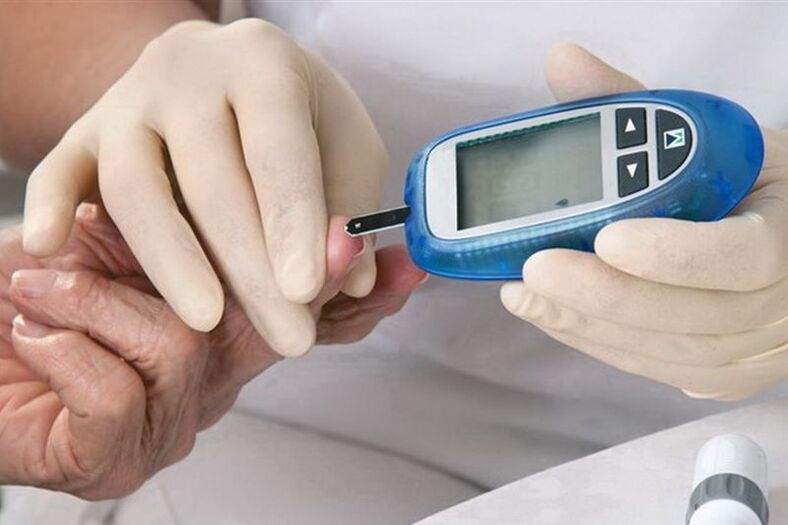Diabetes is considered the most common endocrine disease. Improper diet, lack of physical activity and genetic predisposition - these factors increase the risk of its occurrence. Today, approximately 347 million people worldwide suffer from pathology. The number of cases has increased tenfold over the past two decades. Serious complications can be avoided if it is caught early. Therefore, it is important to understand how diabetes manifests itself.
Causes and types of diabetes
Diabetes is a disease characterized by metabolic disorders in the body. It is associated with insufficient production of the hormone insulin by the pancreas. Its deficiency can lead to the accumulation of sugar in the body.

Normally, it should be processed into glucose due to the action of insulin. This process is accompanied by discomfort and other symptoms. The sugar itself is excreted in large amounts in the urine, which can lead to progressive dehydration and constant thirst.
To date, the exact cause of the disease has not been studied. However, doctors have identified a set of factors that increase the risk of its occurrence.
- genetic predisposition.
- overweight.
- Pancreatic pathology (cancer, pancreatitis).
- Exposure to viruses (flu, rubella, and smallpox are especially dangerous).
- Often stressed.
- old age.
The classic classification of the disease prescribes the assignment of its two forms: type 1 and type 2 diabetes. The first option is considered the most dangerous and lifelong. In order to maintain the normal state of the body, continuous intramuscular injection of insulin is required. In the second type, the body produces this hormone, but the amount is not necessary.
There are also the following types of diabetes: pregnancy, diabetes insipidus, steroids, latent, autoimmune, bronze. Each form has its own clinical presentation and curriculum characteristics.
How does type 1 and type 2 diabetes manifest?
Diabetes is a hidden disease. A person may be unaware of a health problem for many years until he falls into a hyperglycemic coma. Therefore, it is important to understand the main manifestations of pathology, taking into account their diversity.
Table 1. Manifestations of Type 1 and Type 2 Diabetes
| type of diabetes | clinical picture |
|---|---|
| type 1 diabetes |
|
| type 2 diabetes |
|
The clinical presentation may vary slightly depending on the age and gender of the patient.
Signs of diabetes in children
Identifying pathology in children is easy. It is important to do this in a timely manner in order to avoid the development of a diabetic coma. It occurs spontaneously and can be fatal if the child does not receive medical attention.
Early symptoms of diabetes in children are:
- Frequent and heavy urination. If the baby still goes to the pot, it is easy to recognize this symptom. Urinary problems mainly occur at night. Parents often need to change diapers and bedding.
- Children are always thirsty. If diabetes is suspected, preserves and juices should be replaced with plain water. If thirst does not decrease in this condition, you should consult your doctor.
- The weight and quantity of food were inconsistent. The child ate a lot but didn't get better. Another option is also possible: the child eats very little, but he is gaining weight rapidly.
In addition to these symptoms, diabetes may also present with itching, persistent fatigue even after rest, and dry mouth.
The incidence of diabetes in men
The clinical manifestations of male disease are not different from general clinical manifestations. However, inflammation of the foreskin, of the entire urethra, can be added to all signs. This is due to frequent urination. Urine has a high concentration of sugar, which can irritate organ tissues and the foreskin itself.
women with diabetes
During fair sex, the onset of the disease is manifested by intense thirst, lethargy, and itching. However, the pathological process often affects the reproductive system and is accompanied by the following symptoms:
- Violation of the menstrual cycle. The bloody discharge may disappear completely within a few months and then appear as a clot.
- Breast ulcers. They are often mistaken for allergies, but ongoing treatments have not led to positive results.
- Weight loss or gain for no apparent reason.
The latter symptom is more common in women than the other symptoms. With a high-calorie diet, patients can lose up to 10 kilograms of body weight. On the other hand, some people gain weight while sticking to a strict diet. Often this violation is considered a malfunction of the hormonal system. Serious health problems are discovered only after passing the test.
Symptoms of gestational diabetes
Gestational diabetes occurs only in pregnant women. It has no specific external characteristics. It is usually found during routine check-ups and is regularly prescribed to women in power. Diagnosis is based on the results of blood and urine tests.
The external manifestations of the disease are virtually indistinguishable from type 1 and type 2 diabetes. We're talking about nausea, weakness, constant thirst. These symptoms do not occur in isolation and do not indicate poisoning. They develop mainly in the second and third trimesters.
The gestational form of the disease poses no immediate threat to the woman and fetus in the womb. However, this can negatively impact her overall health and pregnancy process. High blood sugar levels can cause heavier (4kg or more) babies to be born.
Often this is considered a prerequisite for obesity and the development of diabetes directly in children. In some cases there is a slight delay in development. Sometimes jaundice and hypoglycemia are diagnosed.
What if you have symptoms of diabetes?
If you suspect diabetes, you should not self-medicate or ignore the first symptoms. This disorder is within the competence of endocrinologists. However, a therapist can make a diagnosis.
In any case, to determine if there is a pathological process, you will need to seek medical help. The specialist will first listen to the patient's complaints, study his medical history, and perform a physical examination. Only on the basis of these measures can a preliminary diagnosis be made. To confirm it, you need to do a full inspection.
Disease diagnosis
Any study of suspected diabetes aims to determine the level of glucose in the blood.
In most cases, patients will be asked to have their blood sugar tested. Avoid eating 8-12 hours before delivery. Alcohol is also banned. Better to quit smoking. Typically, the glucose indicator should be 5. 5 mmol per liter. Additional checks are assigned if this parameter is 7 units or more.
Ask the patient to undergo a glucose tolerance test. The analysis consists of several parts. First, the patient undergoes a standard fasting blood test. Then, in a medical facility, he drank a glass of sweetened water (75 grams per 200 ml of water). After 2 hours, he had another blood test.
In healthy people, rates were as high as 5. 5 mmol per liter after the first study and as high as 7. 8 mmol per liter after the second study. If these parameters are slightly exceeded (a few tenths), the doctor will make a conclusion about a prediabetic condition. Indicators well above these numbers already indicate diabetes.
Some prescribe an analysis of glycated hemoglobin. With it, you can track your blood glucose status over the past 3 months. Typically, this number should be less than 5. 7%. With values in the range of 5. 7-6. 4%, the risk of developing type 2 diabetes is high.

In this case, the patient should discuss measures to prevent the disease with the doctor. When the glycated hemoglobin level exceeds 6. 5%, diabetes is likely. However, additional testing is required to confirm.
possible complications
The disease itself does not pose a threat to human life, but the doctor's advice should be followed. Its complications are dangerous. Among them, the most common are the following:
- Neuropathy. Pathology manifests as burning, severe pain and numbness in the lower extremity area. It develops due to metabolic disturbances in the central nervous system. Treatment consists of taking medicines containing lipoic acid. By seeking prompt medical help, the patient managed to restore nerve tissue.
- Diabetic coma. Her symptoms are growing rapidly. Therefore, the patient was hospitalized immediately. At first, he may complain of darkened eyes and low intelligence. There are a variety of conditions, but ketoacidosis is the most common. It is characterized by the accumulation of toxins in the body, which rapidly destroys nerve cells.
- Nutritional ulcers. It is a disease that seriously impairs the quality of human life. If treatment is not started in time, trophic ulcers may begin to fester.
Diabetes can also lead to other health problems. They manifest themselves in the form of disrupting the function of various organ systems (liver, kidneys, visual organs).
prevent diabetes
First, it is important to note that the emergence of type 1 diabetes is difficult to predict. The disease is mainly hereditary. Various viruses increase the likelihood of its development.
Type 2 diabetes is easier to prevent. Its occurrence is directly dependent on the quality of human life. Addiction, an inactive lifestyle, alcoholism—all of these factors contribute to the disease. Therefore, doctors recommend the following for its prevention:
- Control your weight (try to eat properly and well-balanced).
- Monitor your blood pressure and see a doctor for treatment if necessary.
- Engage in challenging sports.
- Prompt treatment of diseases, especially those related to the endocrine system.
If you follow these simple guidelines, you can protect yourself from diabetes. A healthy lifestyle and proper nutrition are the keys to the full functioning of the body.
Diabetes is a serious disease that primarily requires a lifetime intake of insulin. If you neglect its treatment, the pathological process can become more complicated and lead to rather unpleasant consequences.
Among the latter, attention should be paid to diabetic coma, lower extremity trophic ulcer and neuropathy. In order to protect yourself from such problems, it is important to know the initial symptoms of the disease and to consult a doctor immediately if they appear. After passing tests that mainly include the assessment of blood glucose parameters, the specialist will be able to choose a treatment method.

























